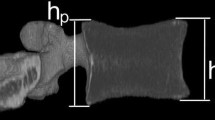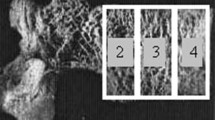Abstract
Spinal bone mineral density (BMD) is traditionally measured by dual-energy X-ray absorptiometry (DXA) in the anteroposterior (AP) projection which includes both the vertebral body and the posterior elements in the measurement. The posterior elements, however, contribute little to the compressive strength of the spine. It has therefore been suggested that spinal BMD measured in the lateral projection, including only the vertebral body in the measurement, might be more appropriate for the prediction of fracture risk. To date little clinical evidence has been presented to support this assumption. To address the issue, we measured vertebral, hip and forearm BMD in situ in 14 human cadavers and remeasured BMD in vitro in excised vertebrae. Lateral spinal measurements were performed in the decubitus position. Fracture force and other bio-mechanical measures were determined for 32 vertebrae in a mechanical testing machine and compared with BMD values in situ and in vitro. Correlations of BMD with vertebral fracture force werer=0.48/0.51 (in situ/in vitro) for the AP spinal measurements,r=0.45/0.71 (in situ/in vitro) for the lateral spinal measurements, andr=0.64 andr=0.53 for total hip and forearm measurements in situ, respectively. Thus, despite an apparent diagnostic advantage in vitro, lateral spinal BMD measurement was not superior to AP measurement when performed in situ. This observation corresponds well with previous clinical findings and is probably due to the larger accuracy error in the lateral than in the AP projection resulting from a lower ratio of bone to soft tissue. The high correlation between hip BMD and vertebral fracture force suggests that hip measurement may prove as useful for vertebral fracture risk assessment as spinal measurement in any projection, especially in the elderly with a high prevalence of degenerative changes in the spine.
Similar content being viewed by others
References
Consensus Development Conference: diagnosis, prophylaxis, and treatment of osteoporosis. Am J Med 1993;94:646–50.
Chalmers J, Weaver JK. Cancellous bone: its strength and changes with aging and an evaluation of some methods for measuring its mineral content. Cancellous Bone 1966;48A:299–308.
Rockoff SD, Sweet E, Bleustein J. The relative contribution of trabecular and cortical bone to the strength of human lumbar vertebrae. Calcif Tissue Res 1969;3:163–75.
Hansson T, Roos B, Nachemson A. The bone mineral content and ultimate compressive strength of lumbar vertebrae. Spine 1980;5:46–55.
McBroom RJ, Hayes WC, Edwards WT, Goldberg RP, White AA. Prediction of vertebral body compressive fracture using quantitative computed tomography. J Bone Joint surg [Am] 1985;67:1206–14.
Melton LJ III, Atkinson EJ, O'Fallon WM, Wahner HW, Riggs BL. Long-term fracture prediction by bone mineral assessed at different skeletal sites. J Bone Miner Res 1993;8:1227–33.
Miller JAA, Haderpeck KA, Schultz AB. Posterior element loads in lumbar motion segments. Spine 1983;8:331–7.
Yang KH, King AI. Mechanism of facet load transmission as a hypothesis for low-back pain. Spine 1984;9:557–65.
Uebelhart D, Duboeuf F, Meunier PJ, Delmas PD. Lateral dual-photon absorptiometry: a new technique to measure the bone mineral density at the lumbar spine. J Bone Miner Res 1990;5:525–31.
Ørtoft G, Mosekilde L, Hasling C. Mosekilde L. Estimation of vertebral body strength by dual photon absorptiometry in elderly individuals: comparison between measurements of total vertebral body bone mineral. Bone 1993;14:667–73.
Myers BS, Arbogast KB, Lobaugh B, Harper KD, Richardson WJ, Drezner MK. Improved assessment of lumbar vertebral body strength using supine lateral dual-energy X-ray absorptiometry. J Bone Miner Res 1994;9:687–93.
Svendsen OL, Hassager C, Skødt V, Christiansen C. Impact of soft tissue on in-vivo accuracy of bone mineral measurements in the spine, hip and forearm: a human cadaver study. J Bone Miner Res 1995;10:868–73.
Hansen MA, Hassager C, Overgaard K, Marslew U, Riis BJ, Christiansen C. Dual energy X-ray absorptiometry: a precise method of measuring bone mineral density in the lumbar spine. J Nucl Med 1990;31:1156–62.
Svendsen OL, Marslew U, Hassager C, Christiansen C. Measurement of bone mineral density of the proximal femur by two commercially available dual energy X-ray absorptiometric systems. Eur J Nucl Med 1992;19:41–6.
Nilas L, Borg J, Gotfredsen A, Christiansen C. Comparison of single- and dual-photon absorptiometry in postmenopausal bone loss. J Nucl Med 1985;26:1257–62.
Gotfredsen A, Pødenphant J, Nørgaard H, Nilas L, Nielsen VAH, Christiansen C. Accuracy of lumbar spine bone mineral content by dual-photon absorptiometry. J Nucl Med 1988;29:248–54.
Jensen J-EB, Stang H, Kringsholm B, Sørensen OH. Biomechanical quality of trabecular bone: a new method (abstract). International Conference on Progress in Bone and Mineral Research, Vienna 1994, abstr 59.
Neill JJ, Dunn OJ. Equality of dependent correlation coefficients. Biometrics 1975;31:531–43.
Rupich R, Pacifici R, Griffin M, Vered I, Susman N, Avioli LV. Lateral dual-energy radiotherapy: a new method for measuring vertebral bone density. A preliminary study. J Clin Endocrinol Metab 1990;70:1768–70.
Slosman DO, Rizzoli R, Donath A, Bonjour J-P. Vertebral bone mineral density measured laterally by dual-energy x-ray absorptiometry. Osteoporosis Int 1990;1:23–9.
Bjarnson K, Nilas L, Hassager C, Christiansen C. Dual energy X-ray absorptiometry of the spine: lateral decubitus vs antero-posterior projection in osteoporotic women. Comparison to single energy X-ray absorptiometry of the forearm. Bone 1995;16:255–60.
Bouxsein ML, Moro M, Courtney AC, Myers ER, Hayes WC. Ultrasonic and densitometric properties of the calcaneus correlate with the strength of cadaveric proximal femurs and lumbar vertebrae (abstract). J Bone Miner Res 1994;9 [Suppl 1]: abstr B186.
Edmondston SJ, Singer KP, Day RE, Breidahl PD, Prince RI. In-vivo relationship between vertebral body density, size, and compressive strength in the elderly thoracolumbar spine. Clin Biomech 1994;9:180–6.
Kazarian L, Graves GA. Compressive strength characteristics of the human vertebral centrum. Spine 1977;2:1–14.
Evans FG, Lebow M. Regional differences in some of the physical properties of the human femur. J Appl Physiol 1951;3:563–72.
Dempster WT, Liddicoat R. Compact bone as a non-isotropic material. Am J Anat 1952;91:331–62.
Author information
Authors and Affiliations
Rights and permissions
About this article
Cite this article
Bjarnason, K., Hassager, C., Svendsen, O.L. et al. Anteroposterior and lateral spinal DXA for the assessment of vertebral body strength: Comparison with hip and forearm measurement. Osteoporosis Int 6, 37–42 (1996). https://doi.org/10.1007/BF01626536
Received:
Accepted:
Issue Date:
DOI: https://doi.org/10.1007/BF01626536




